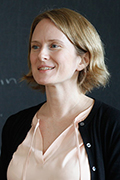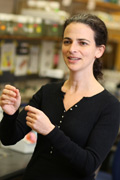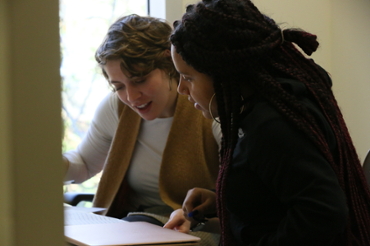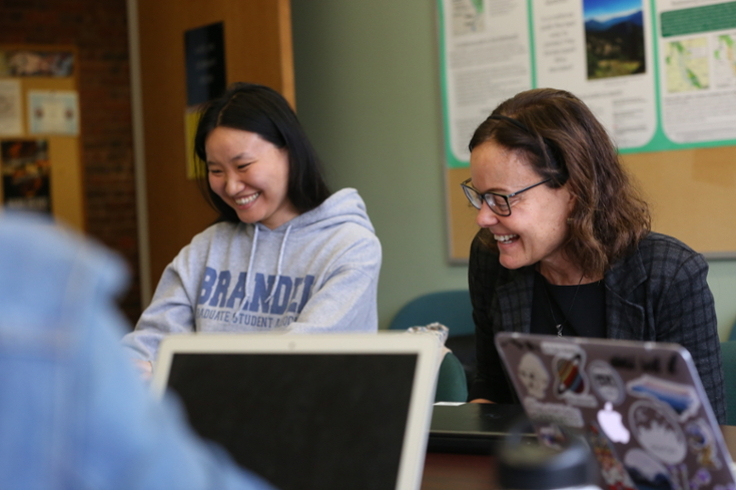2024 University Prize Instructors Contribute to University Culture of Learning
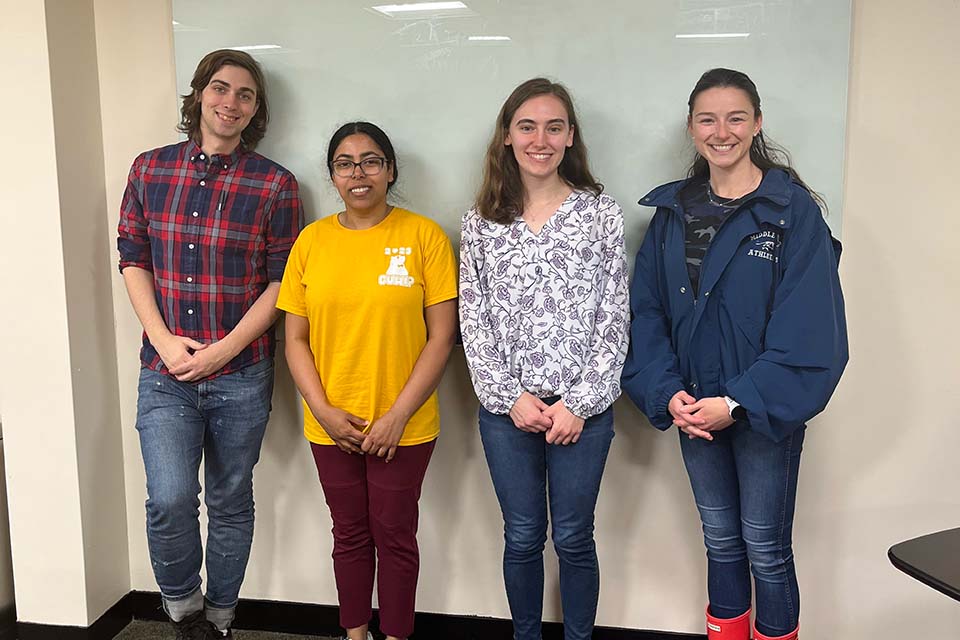
June 13, 2024
Abigail Arnold | Graduate School of Arts and Sciences
On Wednesday afternoons in the spring of 2024, you could find Kanaya Malakar, Emma McGuirk, Anne Silveira, and Nathanial Walker gathered in a Brandeis conference room, animatedly discussing their adventures in teaching. While they came from different departments, they had many experiences and questions in common. How do you make in-class group work productive? How can you target students with different levels of experience in a topic? How do you handle the rise of AI?
Despite their passion for teaching, the four are not Brandeis faculty. They are PhD students who received a Spring 2024 University Prize Instructorship (UPI), the result of a competitive process in which they designed and were selected to teach their own upper-level undergraduate courses. The award goes back thirty years and has produced many students who went on to tenure-track faculty jobs, citing their UPI experience as a contributor to their job market success.
This year’s cohort, the latest in the tradition, created exciting opportunities for undergraduates to take courses that aren’t typically available at Brandeis. Malakar, of Physics, taught “Algorithmic Art,” in which students used principles of physics and mathematics to code and create visual art. McGuirk, of Neuroscience, and Silveira, of Molecular and Cell Biology, joined together to teach “Seeing Inside Cells: Using Microscopy to Visualize Cellular Dynamics,” showing students techniques of microscopy that might be used in the lab. And Walker, of Politics, taught “Sovereignty: Continuity and Change,” exploring the concept of sovereignty in international relations and its many applications. Despite their individualized topics, they regularly came together as a group, along with Brandeis Graduate School of Arts and Sciences (GSAS) and Center for Teaching and Learning staff, for workshops and collaboration to develop further as instructors.
Another thing the UPI instructors had in common? How rewarding they found the experience. “I enjoyed helping students apply the information discussed in class to scientific problems,” said Silveira. “It was rewarding to see them understand and get excited about the content. Students would share how what we were teaching them in the classroom was applicable to lab work they were doing outside of class, which was fun to hear.” Her co-teacher, McGuirk, added, “I thoroughly enjoyed meeting every week and putting our heads together to come up with creative ways to teach the fundamentals of microscopy but also ways in which microscopes can be used to answer some of the field's most exciting and interesting biological questions. Through this experience, I learned there is no ‘right way’ to teach and that by implementing multiple different teaching styles and strategies, students are more likely to grasp and connect with the material.”
Malakar agreed that teaching a UPI course was a mutually positive experience for her and the students. “I was very motivated by science-inspired art and I was eager to share it with others,” she said. “But I was not entirely sure how this course was going to be useful to the students who would take it. However after I started teaching the course, students told me that visualizing important math concepts really helped them get an intuition for it. Some of them said that they learnt basic coding; some folks who already had coding backgrounds said that they learnt how to use modules or write functions. And I think most of them said that this was a fun course that had a perfect balance of creativity and technicality.” Walker felt similarly, saying that he both saw his students learn and learned a lot himself. “My favorite part of teaching was seeing each of my students grow as scholars. Through discussion and class assignments throughout the semester, I’ve been privileged to see them grow and realize what they sought in taking the class,” he said. “Teaching a UPI course helped me learn a whole lot of things that I could only really learn by running a class on my own: how to properly prepare a lecture or class activity, how to communicate standards to students, and how to solicit feedback. One particular thing I learned is how to manage a class when things inevitably go wrong: how to improvise and think on your feet to make the learning experience as good as possible even with adversity.”
Working together as a cohort also helped the four grow as instructors. “We all had unique and varying experiences that we could share with each other and learn from,” said Walker. “By talking with my peers and advisors I learned about different approaches to teaching, how to solve unique and often unexpected problems and, most importantly, that teaching is an art that can always be improved,” added Silveira. Alyssa Stalsberg Canelli, GSAS’s Associate Dean of Academic Affairs, who led the cohort, said that working with them was one of the best parts of her job. “I really enjoy the community we created together over the course of the semester,” she said. “We learned together, problem-solved, commiserated, and celebrated all the ups and downs of the semester.”
Canelli emphasized the ways in which the UPI program benefits both the individual student instructors and the university as a whole. “It's an opportunity to completely design and teach an upper-level undergraduate course – most PhD students can get experience teaching lower-level courses, but this kind of teaching opportunity is quite rare,” she said. “It connects the teaching and research mission of the university; PhD students are at the very forefront of new research ideas and discoveries, and they are able to bring that innovation and enthusiasm into their course design when they teach undergrads. It's a perfect example of the research and teaching excellence that results from what the Framework for the Future calls ‘vertical connectivity!’”
For the UPI instructors, the opportunity to teach the class prepared them for the future and gave them the opportunity to share their own expertise with undergraduates. “Because a major part of being a professor is teaching, I honestly think having pedagogical instruction and experience should be a mandatory part of training future professors,” said Walker. “This type of experience is necessary training for what most PhD students want to do.” “Teaching a UPI significantly strengthened my organizational, time management, and communication skills, ultimately making me a stronger graduate student at Brandeis and equipping me with translational skills for working as a scientist after Brandeis,” said McGuirk. “I was able to give back to the Brandeis community that shaped me into the graduate student I am, which was a privilege,” said Silveira. “Undergraduate students also benefit because they get to learn about a unique topic that would otherwise not be offered. Moreover, by seeing graduate students as their professors, the students might be inspired to inquire about graduate school in a way that could shape their trajectory.”
Furthermore, the UPI is a special opportunity that makes a Brandeis graduate education unique. “I’ve spoken to graduate students at other universities while at national scientific conferences and they wish they had an opportunity like this,” said Silveira. “It is clear that students are eager to take courses like these,” said Malakar, “and I think the UPI is a unique program that Brandeis has that supports new ideas from graduate students. Whenever I mention my course to colleagues and faculty members from other institutions, they always praise that Brandeis has such a novel initiative.” When Brandeis PhD students have the opportunity to come up with creative ideas for undergraduate courses and make them part of the curriculum, everyone benefits – the PhD students themselves, the undergraduates who take their courses, the departments who host them, and, by extension, the university as a whole.
